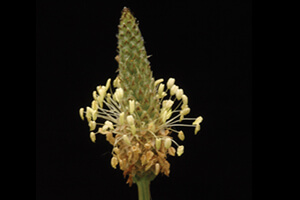
Relatively recently, based on genetic evidence, this family has been expanded to include groups not originally considered to be within the family. The treatment below represents the older view of the family.
In the older view the family consisted of 3 genera and 270 species[smith] of both annual and perennial herbs. The leaves are mostly basal, usually situated alternately around a short distance of stem. The leaf veins are essentially parallel, and the leaf stem’s base at least partly surrounds the floral stem and there are no stipules.1
To investigate the structure of the flower heads and individual flowers within that structure, a hand lens is nearly a necessity and a microscope would be better.
The flowers are arranged in dense clusters at the end of the stem that holds them. They bloom from the bottom upward. The individual flowers are usually bisexual, and radially symmetrical.2 The stamens, petals and sepals are attached below the ovary, making the ovary superior to the other floral parts.
One of the characteristics that helps identify this family is that generally, but not always, the major floral parts (petals, stamens, sepals) come in sets of 4.
The calyx consists of 4 united membranous sepals and is tubular. These might be hard to identify as consisting of four parts and may show up as 4 points on an otherwise united tubular structure. There are four united membranous papery petals and there are generally 4 stamens,( rarely 2) and in both situations they are attached to the petals. The anthers (pollen producing structures) are placed on long filaments that extend beyond the petals of the flower.
The female part (pistil) of the flower consists of 2, more rarely 1 or 4 closely united carpels3 that form a long style that terminates in a head-like stigma. The ovary is located above the attachment point of the petals (superior position), and the place where the seeds develop (placenta) is located at the center of the ovary at the juncture of the generally 2 chambers (locules).
The fruits are either a capsule that opens by a line that runs around the fruit or a hardened single seeded structure with no obvious means of opening (a nut) that is surrounded by the persistent calyx.4
The seeds are often mucilaginous (covered with a sticky substance).
In the field look for plants with basal rosettes of linear-veined leaves with a slender to pencil thick accumulation of nondescript papery flowers that are densely packed above a short or long leafless stem. The individual flower opens from the bottom upward.
The family is of little economic importance. Several species are weeds often found in more or less uncared for lawns and one (Plantago psyllium) is a source of seeds used to make psyllium which is used to combat both constipation and mild diarrhea. Some claim that it is also one of the few laxatives that does not promote flatulence, but my search of the web suggests this is certainly not always the case. My advice: look before you leap!
The family consists largely of weedy plants. There are two genera, Plantago and Littorella (a similar but aquatic plant).
References
Baumgardt, John P. 1982. How to Identify Flowering Plant Families. Timber Press. Portland, Oregan.
Smith, James P. 1977. Vascular Plant Families. Mad River Press Inc., Eureka, Ca.
Narrow-leaved plantain, ribgrass, English plantain, ripple grass, buckthorn
Scientific name: Plantago lanceolata
Synonyms: Plantago altissima[8]
Origin: The species is one of North America’s many introductions and is thought to be from Eurasia.[11]
Plant description: While many references describe the plant as a perennial, the USDA Plants Website[8] indicates that it can act as an annual, a biennial or as a perennial. As a biennial or perennial, it arises from a persistent fibrous root system. The leaves are an elongated lanceolate to elliptic shape and are usually somewhat ascending and range between being hairless to having long, soft, shaggy hairs. They are often twisted and curled and usually range in length between 5 to 25 cm (~2 to 9.8 in) and in width between 1 to 2.5 cm (~0.39 to 0.98in) and possess 3-5 prominent parallel veins in the leaf blade, and at their base, clasp the stem to which the inflorescence is attached. The central floral stem ranges


